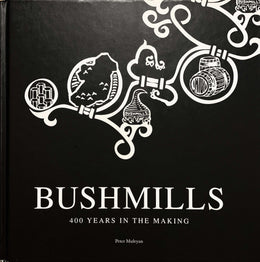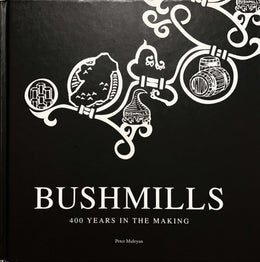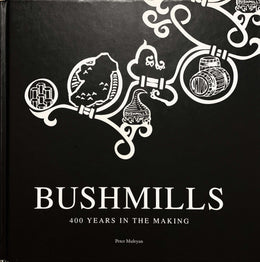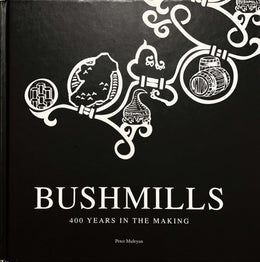Colum Egan is the Old Bushmills Master Distiller and a man who knows a lot about whiskey and a lot about how to manage his team.
"It takes six guys to make our whiskey; that's two per shift. One guy mashes, and one guy runs the still house — that's three shifts over twenty-four hours, so it's a six-man team. The least experienced of these guys has been doing it for 25 years, the most experienced has been at it for 43 years. So these guys know what they're doing. People ask me 'What happens when you leave the distillery?' I tell them, well, if they don't know how to make it after 25 years, we're in trouble."
1. Mashing
The name says everything: mashing. When you look inside the mash tun that Ronnie Brennan finally 'wore out' after 40 years of service, you get a real idea of what is involved in this part of the whiskey making process. It is basically a large saucepan with built in stirrers.
Before the malt is cooked, it is put into a mill and ground into a grist (thus the expression 'grist to the mill'). Ten tonnes of this grist and a load of hot water are emptied into the mash tun, and from then it is a bit like making watery porridge. In this process you do not want the cooked grain: you want the cloudy water, which since everything needs a name, is now called wort.
This wort is drained off, then the process is repeated twice. Each time the water gets hotter and hotter, as more and more maltose is extracted. You may well get a hint of peaches in the air if you are in the mash house at this time. If not they'll have some fine Antrim air for you to breathe, so don't worry.

The three loads of wort are then pumped away — they will go on and become whiskey. The cooked grist or draff is taken away and dried — this will go on to be cattle food. Nothing here is wasted, and if the distillery is lucky they can sometimes sell this draff for more than they paid for the malt, but don't say I told you so.
2. Fermentation
The wort is now a sweet-tasting, milky looking water. It appears to be pretty uninspiring stuff. This is pumped into another large stainless vat called a wash back, where yeast is added. This is where the first magical transformations happen.
Over a period of 59 hours, the yeast consumes the simple sugars in the wort, and you are left with something resembling a sweet-smelling warm beer. This wash is pretty strong stuff too, at around 7.5% abv (alcohol by volume). It won't get any stronger though, as the alcohol in the wash will eventually kill the very yeast that brought it into existence. So to get a more alcoholic spirit, we need to distil.
3. Distillation
The still room is where chemistry and art collide.
The science bit is easy. Alcohol has a lower boiling point than water, so if you heat the wash, the alcohol will evaporate first. Collect that and the job is done.
I told you it was simple! It took two lines to explain the chemistry; the art though will take a lot longer. It is all about variables: from the size of the still; to its shape; from how it is fired to the cat that sleeps underneath it.
"His name is 'Ginger', or 'Whiskey' or whatever comes to mind!" Kenny Garvin operates the stills and feeds the distillery cat that spends a lot of its life curled up by a nice warm still. "He's like myself — he's 'third generation'," he joked. "His grandfather worked here with my grandfather. Take him away and the whiskey just wouldn't taste the same!"
Apart from telling tall tales, the art of the still man is to separate the good stuff from the not-so-good stuff. The exact moment to collect the run and the exact moment to stop cannot be learnt from a book. It takes a keen eye and a steady hand to produce the kind of new-make spirit that will one day carry the Old Bushmills name.
At Bushmills, whiskey is distilled three times. The first pass happens in a wash still.
Kenny MacAuley has been an engineer at Bushmills for over 40 years, and he knows every last washer in the still house.
"The stills used to be heated by coal fires lit underneath, but that stopped in 1965."
Up until this, the stills had flat tops to accommodate the rummagers inside. Rummagers were basically automated stirrers operated by a cog, and they kept the wash moving so it did not burn over the direct heat. When the distillery changed to heating the wash with internal steam jets, the rummagers were skipped, but stills were kept until the mid-1990s, when they were replaced by more elegant ones with swan necks rather than flat tops.
The science remains the same. The liquid that comes from the first distillation is around 25% abv, the second pass raises this to 70%, but it is the third and final distillation that makes Bushmills so special.
No one knows when or why the Irish started distilling their whiskey for a third time. It is pretty unusual, as in most parts of the world whisky is distilled just twice. But one thing is certain: the third pass through the still is crucial to the flavour profile of Old Bushmills. The third distillation produces a lighter, purer spirit at around 83% abv. Scotch takes a lot of its flavour from peat, while Bourbon and Tennessee Whiskey rely a lot on new oak barrels for their flavour profile. But when you take a sip of anything from Old Bushmills, you will taste the whiskey, and most of that flavour will come from the spirit, therefore the distillation process is much more critical here than it would be elsewhere.
4. Maturation
The new-make spirit that flows from the spirit still is as clear as the water in St Columb's Rill, and legally it can't be called `whiskey' until it has been matured in an oak barrel for at least three years. However a whiskey might well mature for a decade or two before being ready to bottle. Think of the barrels as lungs, and the maturation process as deep, deep breathing.
When you first fill a cask, about 3% of the liquid will instantly soak into the wooden barrel. Over the years, as the seasons wax and wane, the temperature and humidity will rise and fall, so the porous wooden cask literally breathes in and out.
When the barrel breathes in, the whiskey that had soaked into the wood is forced back into the cask, bringing with it some of the colour and flavour it has leached from the wood. If it is an ex-Bourbon barrel, the colour will be light and the flavour will be vanilla-like; if it's an old sherry butt, the colour will be much darker and the spirit will taste sweetish.
As the casks breathe out, some of the spirit will get pushed right out of the porous wood and will evaporate. A cask will lose around 2% of its volume every year. Walk into any warehouse and you will smell it everywhere — it is called The Angels' Share'. There are some very happy angels hanging over Bushmills.
Over ten years, a cask will do a lot of breathing, and that is why a good barrel is important. The wood will contribute subtly to the flavour of the final product, and in the decade or more from harvesting the grain, through mashing, to distilling, to maturation, to pouring yourself a glass, a whiskey will only prove as good as the weakest link in that chain.
The maturation process s is important as it imparts to the whiskey the colour and flavour extracted from the wood. Irish whiskey is never matured in new oak barrels, as the raw timber would easily overpower the delicate spirit. However American whiskey has to be matured in new wood; this means there is a constant market for used casks.
Each cask will get used three times at Old Bushmills. Wander through the warehouses and you will see pallets labelled B1, B2, B3 meaning first, second and third fill bourbon, but remember these casks have already been used to mature American whiskey for at least a year. According to Colum Egan, every barrel has a set life span.
"Each time you use a cask, the wood will make a smaller contribution to the whiskey, it kind of gets worn out. After the third use, I feel it's time to send them to the garden centre. You get some beautiful flower displays in our old barrels!"
Bourbon barrels are hugely important at Old Bushmills, but there are many other types of cask here. In fact there seems to have been a long tradition of experimenting with different ageing techniques. Harry Elliott, who worked in maturation for 43 years, remembers using rum, sherry and other exotic woods decades ago. Today's public car park used to be the barrel store.
Nowadays the casks arrive by container ready assembled. The cooper's job then is to check each and every cask. Sometimes a stave may need replacing, or the hoops may need tightening, and there is no point trying to do repairs when a barrel is full of whiskey.
It is possible to buy cheaper barrels on the open market, but with wood, you get what you pay for. The policy here is to do business with one firm that can be trusted. So instead of getting casks from just one distillery, the American oak barrels that will be used by Old Bushmills come from Kelvin Cooperage in Kentucky. They know the kind of quality that is required and will scan all the American distilleries to find what is needed, so the 200 litre casks used here do not come from Diageo central procurement. Darryl McNally, the Distillery Operations Manager, is proud of their wood policy and their decision to be 'pernickety' and work with Kelvin.
"It's a relationship built on trust. Yes, it's kind of touchyfeely, but it makes for good business, and that makes for good whiskey."
In the warehouses, you will find Irish whiskey maturing in casks that once held Maker's Mark, Ancient Age and Four Roses.
Sherry wood also plays a part in the Old Bushmills story, and its effect can be seen and tasted most noticeably in Black Bush. The sherry butts are made from European oak, cost nearly 15 times as much as bourbon barrels and they can hold twice as much whiskey. All the butts used at Old Bushmills come from just the one source, as you have to be very careful with these casks.
"You can easily over-sherry a whiskey," as Colum Egan puts it. "You have to trust the casks are from a source you know, or you are simply wasting the cost of the cask and 500 litres of whiskey."
It is an expensive mistake to make, so Colum only trusts Antonio Paez who runs a family-owned bodega in Jerez, southern Spain. He fills the casks to be used with Oloroso and then stores them for two years, before they are shipped to Northern Ireland.
Similarly, Sandeman season butts with Tawny Port for two years in Porto, Portugal while Madeira, a small Portuguese island in the Atlantic, is the source of the wood used to finish the Twenty-One-Year-Old.
How do you know when a whiskey is ready? That is the great imponderable. There is always a variation in casks. Even two filled side by side with the same new-make spirit may come out tasting very different. So the rule is: it is ready when it is ready. Therefore it is something the Master Distiller and Master Blender simply keep an eye and a nose on, and they rely on gut instinct and good taste to know when a cask is ready.
5. Blending
Helen Mulholland is the Old Bushmills Master Blender, the first woman in Irish history to hold such an important role.
The various casks of colours, flavours, accents and scents are lined up by Colum. These are what she works with to produce blends like Bushmills Original and Black Bush.
"It's down to how it smells, tastes and how the flavours all work together. We only produce malt whiskey on site — one product. The base spirit has to be perfect. But the maturation in wooden casks is what gives each whiskey its individual character."
With whiskeys varying from cask to cask, and with a brand needing to remain consistent, Helen Mulholland has her hands full. Each blend, and indeed the ten-year-old Single Malt, has its own component vat. The elements that make up, say, a Black Bush are married in a huge 90,000 litre tank, but only 40,000 litres or so are ever drawn off. That leaves 50,000 litres of old whiskey, always there to mix with the new stuff. It helps Helen iron out any remaining `wrinkles' in a brand. The component vats then are kept topped up at all times.
Finally, visitors to Bushmills who take the tour may notice that the warehouses are numbered curiously. They go from 7 to 17. It is not that the first six have gone missing, it has to do with the age of the place. The distillery is so old that the place was numbered using a system employed by the Customs and Excise when they were resident there. At that time every part of the whiskey making process was numbered, so that the first six 'warehouses' are in fact inside the distillery, and related to the mashing, fermenting and distilling areas. Now you know!
6. Tasting
The final part of the whiskey making process is the enjoyment of the spirit, so it is important to remember what whiskey is and is not about.
For a start whiskey is not about spending lots of money. While you would spend a fortune to enjoy the finest wines in the world, the finest whiskeys are far less taxing on the wallet, and far more accessible. Whiskey then is about honesty, about taking time to relax. It is traditionally a country drink, made by honest people to share and enjoy at the end of a hard day. So why change what has worked for so long, and why make hard work of something that is not?
According to Colum Egan, the best time and place to sip a Bushmills is at dawn on the Giant's Causeway. But let's face it: that is not really that practical. So instead here is my quick guide to Whiskey and the Art of Sensual Pleasure.
Hearing: Break the seal and listen to the glug, glug, glug as you put a couple of fingers' worth into a glass.
Sight: Look at the colour, which can tell you a lot about the whiskey in your glass.
Smell: Take a long slow sniff... maybe add a drop of water to open the bouquet.
Touch: Take a good mouthful...
Taste: Even before you swallow you will start tasting the fruits of Old Bushmills.
You will not find 'tasting notes' here. I don't want to tell you what I think — I want you to think for yourself. But if you want to record your own notes (and I sincerely hope you do) please use what follows as a roadmap to help you on your way. And keep it simple:
"As far as tasting notes go," says Colum Egan, "I like to sum up the whiskies with a couple of words...it helps define them, it helps create character."
Bushmills Original
Key Words: Fruity Vanilla

(Image Source: Master of Malt)
It is very unusual in the world of whiskey to have blends and malts selling under the same name. But this is Old Bushmills, and here things have always been a bit quirky and a bit different.
This gentle giant has been around in one form or another since grain whiskey was first produced at Coleraine in 1954, though you could trace its heritage back even further, to when the Boyds blended Bushmills malt with grain whiskeys sourced from elsewhere in Ireland. It is not surprising that over time this brand has been called lots of things, including Home Trade, Three Star and White Bush, but nowadays Bushmills Original seems to do the trick.
Although in the United States this whiskey outsells all the other Bushmills whiskey combined, on the home market it was rather neglected by its previous owners.
Guide to Tasting:
The whiskey has a nice light colour. Colour can tell you a lot. There is no reddish tint here, so you won't taste any sherry wood. This is a typically bourbon-matured whiskey.
It is a friendly whiskey, with a welcoming nose that almost pulls you into the glass. The nose can smell things in parts per billion, so breathe in the whiskey and see what sparks into your mind. But don't stay too long, or the alcohol will anaesthetise your nasal passages and you will smell nothing.
Add some water. This doesn't water it down — not unless you add a huge splash, that is. So add a couple of drops and watch it eddy in the whiskey. Whiskey is kind of oily, so what you are doing here is breaking the surface, giving the aromas a chance to move about and release their flavour.
Expect peach, hints of the still house here. The vanilla, which comes from the American oak casks, is gentle. Leave it in the glass for a while, however, and it gets stronger and more pronounced.
This is an easy whiskey, made to enjoy. At around five years old, it is not a complicated whiskey, but it does not have to be. There is a lot to appreciate here if you take your time and if you are new to whiskey, this is a great place to start.
Finally it is great value, and a yardstick to measure all other whiskeys against.
Black Bush
Key Words: Nutty Sweetness

(Image Source: Master of Malt)
Black Bush is the second famous blend to come from the North Antrim distillery. It is the lovable rogue of the bunch, so not surprisingly it has a hugely loyal following right around the globe, and some very famous fans.
The whiskey is a high malt blend, but it is the grain that is really interesting. You see unlike regular grain whiskey, which is made in a continuous still, this is made in a traditional copper still. A small amount of it goes into Bushmills Original, but in Black Bush it really comes into its own. It has a fantastic texture and great mouth feel, particularly as a large proportion of the whiskey is matured in sherry wood.
Hold the whiskey up to the light and you will catch the amber glow. This burnished copper heart is particular to Black Bush and quite unlike anything else.
Guide to Tasting:
The nose here is fuller, bigger, bolder and brighter than Bushmills Original.
Add some water and release an even more intense blast of aroma. You may get a warm hint of a Spanish bodega — that is the sherry wood at work — but notice how it is not overpowering. Here the spirit and the wood are in perfect harmony, one singing to the other on the tip of your nose.
When you sip, you will get the unique mouth feel that comes from the grain whiskey. It somehow does not feel wet. Black Bush just glides around the mouth like liquid silk.
The finish is what we call the flavours that are left kicking around your mouth after you swallow. Sometimes a whiskey's finish is short, sometimes it goes on and on, and on occasion it can be rather nasty. Here however the quality of the casks is reflected in the sweet warm glow that toasts the back of the throat.
Bushmills 1608
Key Words: Spicy Malt

(Image Source: Master of Malt)
Every anniversary deserves to be celebrated. Not many of us get to party on our 400th birthday, so it was clear a very special whiskey was needed for a very special occasion. But where to start?
Every Master Distiller experiments. They play around with grain, with mashing and distilling, but mostly maturation as it is the easiest. Not all the experiments work, but some do, and this is how change happens.
"We always do different things," Colum explained. "But we're not trying to show how clever we are, we are simply [being] innovative; trying to find new ways of making great whiskey."
So at any moment in time there are a range of different whiskeys maturing in the warehouses, but not all of them work and not all are ready.
When Colum Egan went rummaging in the Old Bushmills warehouses, he found lots of interesting casks laid down by his predecessors, but he was intrigued by one particular batch. Some years previously the Master Distiller had made whiskey using crystal malt. Although common enough in breweries, especially in micro-breweries, where it is used to give beer extra mouthfeel, no other distillery Colum had ever heard of had used crystal malt to make whiskey.
Excited as Colum was, "it just wasn't totally there". So he added just a few per cent of old grain whiskey. "And that added the balance I was looking for," he said. "The grain pulls it together."
Ronnie Brennan remembers doing the mash for the crystal malt run.
"The distillery does a lot of unusual stuff, but most of it never sees the light of day. But I remember well doing 25 mashes of crystal malt, because there was a very different smell from it: and not a nice one either! It was very strong and to be honest I didn't think it would amount to much."
However Ronnie now agrees that his mash of crystal malt has made an exceptional whiskey. This just goes to show that there is an art to distilling as well as a science.
Colum Egan is clearly rather proud of Bushmills 1608.
"Everyone was expecting us to release a new Single Malt for the anniversary, so going with a blend was, I feel, brave and innovative. But we didn't do it to be pig-headed, we just went with the best whiskey we could find at that time, and it just happened to be a blend."
Crystal malt is made by preheating the drum that will be used to malt the barley. The barley then hits a hot drum and is toasted before being blasted with air at 500°C. This literally crystallises the simple sugars that coat the grain. If you bite a grain of crystal malt, it has a crisp golden shell that cracks like a sugar coated sweet. The flavour is similar to the crisp topping on crème brûlée.
This results in a whiskey that is similar to the ten-year-old malt, but strangely different. For the record, this is a new release, not to be confused with an earlier, now discontinued whiskey which was called '1608 Reserve', and sported a purple and blue label.
Guide to Tasting:
Bushmills 1608 is a premium blended Irish whiskey. At the heart of 1608 is that crystal malt whiskey, and it does indeed give a unique sensual mouthfeel. The malt is matured in a combination of American oak casks and Spanish Oloroso Sherry butts, which lends extra layers of complexity to an already fine dram.
More often than not, grain whiskey is firmer than malt. You can normally feel it as you swallow, but here the grain is so soft that it is unnoticeable. It all works so well that picking out the individual notes would be like trying to pick apart a fine piece of music. Don't bother, instead just let it wash over you.
Bushmills 1608 is bottled at the slightly higher than normal strength of 46% abv for optimum flavour development, so you may need to add a wee drop more water than normal.
10 Year Old Single Malt
Key Words: Malty Chocolate

(Image Source: Master of Malt)
There has been a ten-year-old single malt from Old Bushmills on sale since the late nineteenth century. So they must be doing something right.
In the ten-year-old, you can really start to appreciate the Bushmills malt DNA; that is, the signature that runs right through the range. Younger versions of this malt can be found in all the blends, but here for the first time it can be tasted on its own.
"What we do with the Ten-Year-Old," says Colum Egan, "is we mature, or age, a portion of it, just a small amount, in sherry-seasoned casks, just to give it a hint of that sweetness."
Indeed there is not a huge amount of sherry influence here, either in the colour or in the taste. This is a very clean, malty whiskey — indeed if you want to know what whiskey writers mean by malty, smell this whiskey.
Guide to Tasting:
Colum calls the ten-year-old "a very easy, everyday sipping malt". And indeed if you hold a glass of this malt on its side and then drizzle in some water, you will see it eddy and spin — catch the hints of malt and chocolate as they spiral out of the glass.
This is a very charming whiskey, one even non-whiskey drinkers warm to. It is light, so expect to find honey on the edge of your cheeks. Some people get hints of pastry, some of apples: I get a far off rumble of fine liquorice, but many do not. That is the point. We are all individuals and we all have our own opinions, so don't take my word for it.
Explore: there is so much to be enjoyed here right to the very end, when you might feel a slightly dry, fruity brush on the back of the throat — interesting. I don't know where it comes from and you shouldn't care: it just feels nice.
16 Year Old Single Malt
Key Words: Honeyed Almond

(Image Source: WhiskyBase)
The age statement here simply means that the youngest whiskey used is at least sixteen years old. In any old whiskey you will find the influence of the wood more apparent, but here maturation is taken to a new level with whiskey matured in not one, but three different types of cask.
This single malt was launched in 1996 after Irish Distillers bought 100 port pipes from Sandeman. Fifty of the casks were sent to Midleton, but a Jameson port finish never materialised. However they had more success in Co. Antrim, where Bushmills malt matured in bourbon, sherry and port wood proved a winner.
This brand is pretty much a half-and-half mix of sixteen- year-old bourbon and sixteen-year-old sherry-matured whiskey that are married for 9 months in a port cask. But this is high-wire stuff. Old whiskey is fragile and can easily be overwhelmed by the wood, so after 4 months in the port pipe, the malt is nosed and tasted, and thereafter a very close eye is kept on it.
"It's ready when it's ready, as every port cask is different," said Colum Egan. "Like sherry, port can be very overpowering, so the maturation can't go on too long. We don't take our eyes off it! But I tell you when it comes to emptying the casks, the boys love tipping that stuff There's a great smell!"
In a whiskey of this age, evaporation is also a problem. Remember that every year a whiskey matures, it loses 2% of its volume, so after sixteen years that's nearly 28% of a loss. Nearly a third of the barrel has simply disappeared.
Guide to Tasting:
The contribution that maturation makes to a great whiskey can really be appreciated here. Expect to find a fruity spiciness, also the chocolate that was in the ten-year-old is still here, but it is darker and search for marzipan or praline chocolate. At the end comes the unmistakable port wine finish.
21 Year Old Single Malt
Key Words: Dark Chocolate Raisins

(Image Source: WhiskyBase)
If the sixteen-year-old is a 'high-wire act', then this rather remarkable old whiskey is 'a barrel over Niagara Falls' stuff Launched in 2001, this malt is a 50:50 combination of whiskey matured for 19 years in a combination of bourbon and sherry casks, which is then finished in Madeira drums for another 2 years.
But whiskey matures far more quickly in Ireland that in Scotland, so 21 years is a long, long time. Older doesn't always equal better, so choosing the right wood is crucial. Over time bad sherry casks can add an unpleasant note of sulphur: leave a floral malt in bourbon wood for too long and all you will taste are splinters.
At the end of 19 years the whiskeys are vatted, and refilled into casks that once contained Madeira. However to get the contribution of the Madeira just right, the finishing process can take up to another two years.
Only 900 cases of this whiskey are produced annually. Most of the stock goes to the USA, the biggest market. There is no magic tap in the wall — every drop has to have been laid down at least 21 years ago. This means that there are no extra stocks of this whiskey to be had until 2010. This is a malt to be enjoyed on any rare occasion you can think of.
Guide to Tasting:
The twenty-one-year-old has a deeper, darker, stronger character than anything else produced by the distillery. The chocolate is very dark now, but almost with a clean minty edge. The toffee is darker and the raisins are very chewy. It is a very careful balancing act between spirit, wood and time: get any one of them wrong and this will not work. Of the three, time is the most mercurial and that is something not even Einstein worked out.
Written by Peter Mulryan
The text is an excerpt from "Bushmills: 400 Years in the Making" (pp. 161 - 184), written by Peter Mulryan, published 2008 by Appletree Press Ltd.







